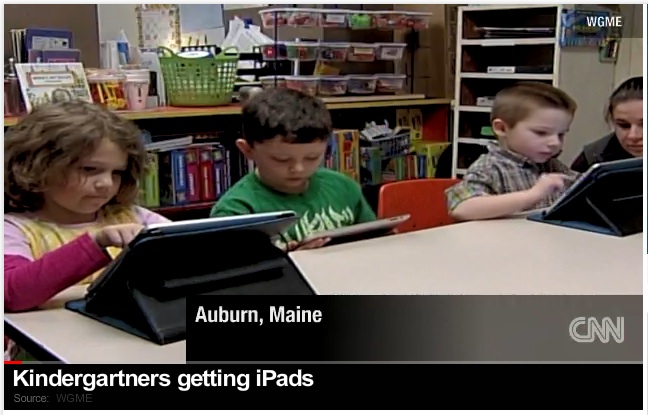Maine's Kindergarten iPad2 1-to-1 Initiative
By Martin Horejsi
Posted on 2011-04-11
CNN video: Kindergartners getting iPads
Years ago, I followed closely the Maine schools 1-to-1 laptop project. I found it interesting on multiple levels, but also I was skeptical for several reasons. Not that I wasn’t in favor of laptops in the classroom or one-to-one initiatives, but for more because of ratios. Concerns of cost/benefit and training/outcomes were obvious, but the the thought festering in my mind was if the collective imagination of the teachers was ready to embrace the immense power and opportunity that a 1 to 1 laptop program would allow. Or instead, would the laptops merely be another vehicle for doing digitally exactly the same things that were done in the analog classroom.
Now it is time to dust off my past thoughts and update them given the changes across education, technology, and the 21st century world in general.
In the meantime, here are a few links to get you up to speed:
The Impact of Maine’s One-to-One Laptop Program on Middle School Teachers and Students: Phase One Summary Evidence Research Report #1
The Impact of Maine’s One-to-One Laptop Program on Middle School Teachers and Students Use of Laptop Computers and Classroom Assessment: Are Teachers Making the Connections? Research Report #4
Article: Going One-to-One from the December 2005/January 2006 issue of Learning in the Digital Age
And a video:
[youtube]http://www.youtube.com/watch?v=rBAduBgV0LI[/youtube]
Personally, I have an iPad and am quite pleased with the device’s potential in education. The iPad2 is even better, but ultimately, it is not the machine but its use. As an instructional technologist encouraging the effective and appropriate application of technology in education, my goals include the fearless use of technology in academic and creative endeavours in order to pursue, with reckless abandon, great teaching and learning. In other words, the tech should become invisible within the experience and the learning be conceptualized and owned independent of the device.
In the above CNN video, I tired to figure out what the students were doing with iPads. A lesson learned (from my perspective anyway) from the earlier Maine 1:1 Laptop initiative was that in order for the technology to truly impact the students within the overall longterm goals of American public education, it had to take a backseat to the content and message of the lessons. However, in studying the 1-to-1 results of the past including those in the links I referenced above, I sometimes had a hard time separating out the computer from its effects.
The yardstick I am using here is not to make the project platform-independent whereby any similar looking or sounding tech might/should yield similar results (as I believe that is often a mistake by the uninformed that leads to 1) the rapid downfall of a project, 2) measurable results contrary to those intended, and 3) a clear path for opponents to challenge the hardware decisions and budget), but instead to focus on the learning objectives and outcomes by which the device is an efficient conduit to personalization and success.
The kindergarten entry point for this integration will also be something to watch. Not only is the project launching from a grade level often contrary to conventional district technology expenditures, but provides a wonderfully effective leverage point causing all grades to follow to either get with the program or risk giving the impression that a student’s matriculation is actually downhill slide into mediocrity.
So grab a bowl of popcorn, make yourself comfortable and let’s watch the action.
Disclaimer: The views expressed in this blog post are those of the author(s) and do not necessarily reflect the official position of the National Science Teaching Association (NSTA).



